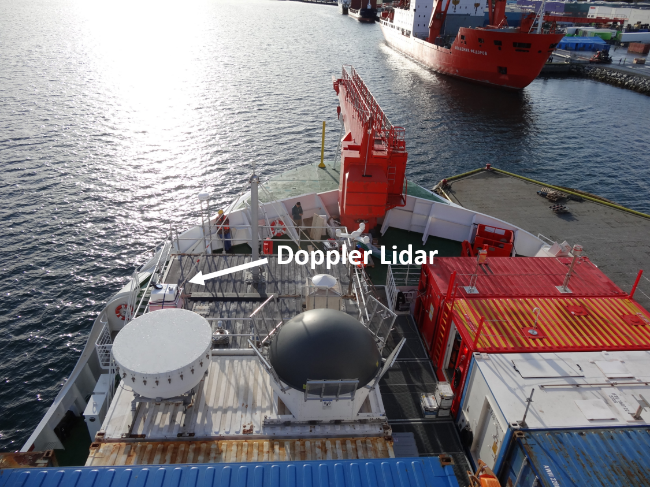MOSAiC Doppler Lidar Motion Correction VAPs Now in Production
Published: 25 July 2024

Two value-added products (VAPs) specifically designed for the 2019–2020 Multidisciplinary Drifting Observatory for the Study of Arctic Climate (MOSAiC) expedition recently moved from evaluation to production.
The Doppler Lidar Motion Correction (DLMC) VAP applies a motion correction to Doppler lidar (DL) measurements collected on the icebreaker R/V Polarstern during MOSAiC. The Doppler Lidar Motion Correction Wind Profiles (DLMCPROF-WIND) VAP uses scan data from DLMC to compute profiles of wind speed and direction.
DLMC requires inertial data from the Atmospheric Radiation Measurement (ARM) user facility’s navigational location and attitude (NAV) system for sea-based deployments. The VAP uses the data to transform the DL beam angles (azimuth and elevation) from the lidar’s frame of reference to an Earth-fixed frame, such that the azimuth angle is measured clockwise from true north and the elevation angle is measured from the local horizon.
In addition, DLMC corrects the observed radial velocity for the heave, surge, and sway velocities of the ship.
The input data for the DLMC process include raw data from the DL and NAV measurements.
During the MOSAiC deployment, the DL was configured to acquire only fixed-point (fpt) data and a user-defined (usr) scan pattern, which consisted of multiple 7-beam plan position indicator scans. ARM provides these data as two individual DLMC products, dlmcfpt and dlmcusr. The dlmcfpt files contain motion-corrected staring data. The dlmcusr product consists of the 7-beam plan position indicator scans.
DLMCPROF-WIND uses the scans from the dlmcusr product to compute the wind profiles.

More information about the VAPs can be found on the DLMC and DLMCPROF-WIND web pages.
Data from these VAPs are available from October 11, 2019, through September 20, 2020. Access the data in the ARM Data Center. (To download the data, first create an ARM account.)
To ask questions or provide feedback on the data, please email VAP contact Rob Newsom or ARM translator Damao Zhang.
The DLMC fixed-point product (dlmcfpt) can be referenced as doi:10.5439/1823260. The DLMC scan product (dlmcusr) can be referenced as doi:10.5439/1824204.
To cite the DLMCPROF-WIND data, please use doi:10.5439/1872823.
Keep up with the Atmospheric Observer
Updates on ARM news, events, and opportunities delivered to your inbox
ARM User Profile
ARM welcomes users from all institutions and nations. A free ARM user account is needed to access ARM data.


















